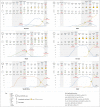Geographical prevalence of SARS-CoV-2 variants, August 2020 to July 2021
- PMID: 35304553
- PMCID: PMC8931783
- DOI: 10.1038/s41598-022-08684-1
Geographical prevalence of SARS-CoV-2 variants, August 2020 to July 2021
Abstract
We extracted one-year genomic data (August 2020-July 2021) from GISAID EpiCoV™ database and estimated monthly proportions of 11 SARS-CoV-2 variants in various geographical regions. From continental perspective, Delta VOC predominated in Africa, Asia, Europe, North America and Oceania, with proportions of 67.58-98.31% in July 2021. In South America, proportion of Delta VOC (23.24%) has been approaching the predominant yet diminishing Gamma VOC (56.86%). We further analyzed monthly data on new COVID-19 cases, new deaths, vaccination status and variant proportions of 6 countries. Delta VOC predominated in all countries except Brazil (Gamma VOC) in July 2021. In most occasions, rise and predominance of Alpha, Beta, Gamma, Delta and Zeta variants were accompanied with surges of new cases, especially after the time point of major lineage interchange. The ascending phases of new cases lasted for 1-5 months with 1.69- to 40.63-fold peak growth, whereas new death tolls varied with regional vaccination status. Our data suggested surges of COVID-19 cases might be predicted from variant surveillance data. Despite vaccine breakthroughs by Delta VOC, death tolls were more stable in countries with better immunization coverage. Another takeaway is the urgent need to improve vaccine efficacy against Delta and emerging variants.
© 2022. The Author(s).
Conflict of interest statement
The authors declare no competing interests.
Figures


References
MeSH terms
Supplementary concepts
LinkOut - more resources
Full Text Sources
Medical
Miscellaneous

